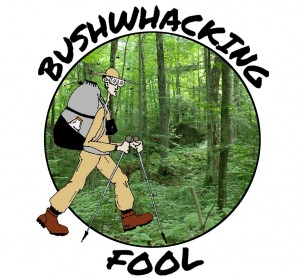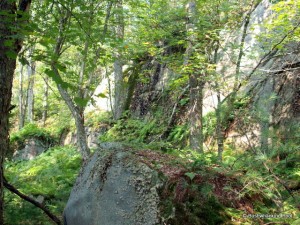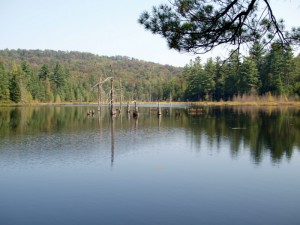
Northern-most beaver pond in Threemile Beaver Meadow
Upon exiting my shelter, a strange sight greets me. An eerie golden hue from the early morning sunlight streaming through from the edge of the beaver pond saturates the entire forest surrounding my campsite (point #15). The hot and hazy conditions, already taking hold at this early morning hour, probably has something to do with the unique glow.
The thought of ever-rising temperatures throughout the day, motivates me to get down to business, such as making breakfast and disassembling my campsite so I can get a jump start before the hottest part of the day arrives. From the weather report, which I heard earlier on my little radio, the hot and humid conditions are here to stay for the next several days.
View Day Two Part One in a larger map
While packing away my gear, I hear a roaring sound to the south. Not the roaring of an animal, more like that of water over a falls. Could this be the sound of Moshier Falls? Is so, why did I notice it beforehand? The roar reminds me of the humming I heard earlier off to the west. What are all these noises? Are they all in my head? Am I going crazy? Unfortunately, this train of thought must wait for another time, as the temperature is rising rapildy.
Section Stats:
Date: September 1, 2010
Length: 0.6 miles (0.6 total daily miles; 3.6 total trip miles)
Difficulty: Easy
Before leaving the area, I go out onto bare rocks to check out the pond one more time to check out the local fauna. Several sandpipers are running up and down the mud flats around the shore, but unfortunately none of them were close enough to identify even with my Leica 8×20 Ultravid binoculars. They are probably either spotted or solitary sandpipers, as they are the most common species in the Adirondacks. In a bush, near the base of the rock, a Lincoln’s sparrow gingerly pops out on the edge of a branch before spotting me and retreating. Three hooded mergansers swim out on the water, seemingly unaware, or at least, unconcerned with my presence. Three shier dabbling ducks swim along the far shore, keeping their distance, the glare from the sun preventing me from identifying them to species. A common yellowthroat sings its “witchity-witchity-witchity” song, while some insects buzz in response and a blue jay shrieks in the distance. Finally, after spending more time than planned, I pull myself away from the gorgeous view and the interesting wildlife, returning to my camping site for some last minute packing.
Around a quarter after nine, I leave my campsite under the large pines and near the large rock behind and start bushwhacking north around the western shore of the large beaver pond. My plan is to head north around the Threemile Beaver Meadow, meeting up with the outlet stream from Bear Pond. From there I can continue northeast along the stream until reaching its source, where I will camp for the evening.
Before going too far, I am in dire need of more water since there is little left from my filtering day before. From my previous trips to the area, I know there is a broad rock just at the water’s edge at a beaver dam separating the north-most pond from its southern neighbor. This rock is an ideal place to filter water, and therefore my immediate destination for the morning.
Large eastern white pines dominate the western shore of the southern-most pond. Often I find myself marveling at these majestic pines, which places me safety at risk from the plentiful death spikes left behind by either a current or a past resident beaver. These death spikes serve as a reminder of all the many young trees chewed down in the prime of their lives by the large rodents. Luckily, the giant pines and other conifer trees keep the undergrowth under control, leaving the spikes easier to spot, and thus avoid. Fortunately, no scarred or torn shins on this occasion. As I navigate through this obstacle course, I try not to think about what could happen if I slipped and fell backwards, regardless I make a mental note of where my ACR Microfix personal locator beacon in located in my backpack, just in such a case.
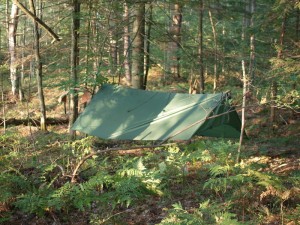
Threemile Beaver Meadow campsite
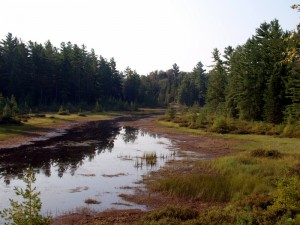
Threemile Beaver Meadow southern-most pond from cliff
Despite the ubiquitous evidence of beaver activity, I fail to observe a single individual animal at the pond where I spent my first night. This is in stark contrast with my previous visit several years ago, when a whole family of the bucktoothed critters harassed me while I spent time on the large rock overlooking the pond.
As I continue north through the forest, following along near the pond’s edge, I pass a rock cliff a short distance over to the west. Toward the cliff, I catch sight of a large bird flapping its wings through a gap in the tree canopy. Given the bird’s size, I suspect it is a turkey vulture, but since I never get another glance, I cannot be certain.
Farther north, several rocky ridges block my progress, forcing me to climb over them. They are not terribly steep, but the effort to climb them over so early in the morning before getting my bushwhacking legs proves arduous, especially in the brutal heat already attained during the mid-morning hours.
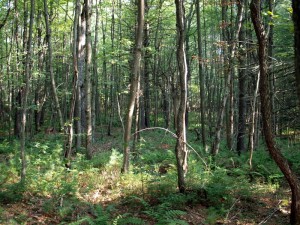
Forest along southern-most beaver pond
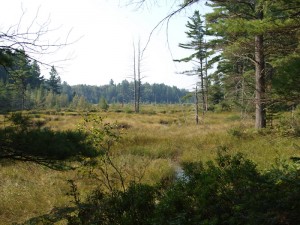
View to the south within Threemile Beaver Meadow
Eventually, my bushwhacking takes me beyond the open water of the pond, which is now just an open and shrubby beaver meadow, serving as a connector between the southern-most pond and the next one to the north. Dense vegetation and wet conditions of the meadow reinforces the wisdom of my decision to stay in the forest, despite the sometimes-dense understory within the forest, the going is relatively straightforward.
Given the heat and my dwindling supply of filtered water, gaining water access becomes an imperative much sooner than my original plans. The peninsula just south of the middle pond of the Threemile Beaver Meadow seems like just the place to do so. Many of the understory hardwoods on the peninsula have twisted stems, as if they endured torture during their formative years as wee sprouts. Perhaps some disturbance affected this area in the past, leaving all but the larger trees unharmed; the numerous hummocks and hollows support this disturbance theory.
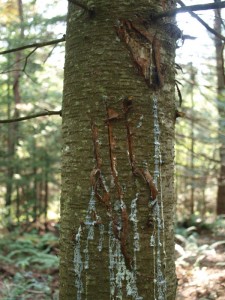
Bear claw marks
As I approach the end of the peninsula, any chance of water access seems highly unlikely, forcing me to abandon my attempt and instead set my sights at another chance at the dam to the north, as I originally intended. From my previous visits to the area, I knew it would be hard to beat the dam, given the broad, flat and half-submerged rock there. In addition, a white pine shades half of the rock, making it a perfect place to rest while my gravity filter performs its magic, without any assistance in the form of pumping required.
After exiting the peninsula and returning to the forest along the western shore of the middle beaver pond, a scarred balsam fir tree grabs my attention. The heavily clawed tree appears like something out of a horror movie, with three clawed marks on several sides. Each gash has soft resin oozing from it down the tree’s trunk, like blood from a deep wound. It appears an irate black bear passed through the area and taken here recently, and took out some of his frustration on this unfortunate tree.
The terrain becomes rougher as I continue (point #17), which requires some careful and slow going. Very large glacial erratics abound, requiring some meandering before it is possible to head for the peninsula between the northern most beaver pond and its neighbor to the south.
Finally, some much-needed drinking water is just a filtering away.
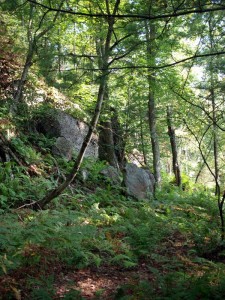
Glacial erratic
Affiliate Disclaimer: Some links within this blog post may send you to a retailer website. If you chose to purchase any product on that site at that time, this author receives a small commission. These commissions provide compensation for the author’s time and effort necessary to provide the content at the Bushwhacking Fool.
